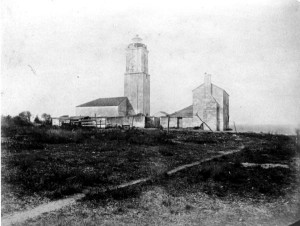
The “Old Spanish Watchtower” after 1824
Historically, the list of known lighthouse keepers for the St. Augustine Lighthouse has begun with Juan Andreu in 1824, when the United States took over the Florida territory and converted an old watchtower into a US lighthouse. Juan Andreu became light keeper at that time and served until 1845. However, research has revealed two new names to add to the beginning of the list, before even Juan Andreu. The digitization of historical resources made these names much easier to find.
Efforts in providing digitized online images of historical documents and records have exploded in recent years. Information once hidden away in repositories, archives and libraries around the world are now accessible to anyone with the technology and familiarity to look. Internet sources like the Internet Archive, The Digital Public Library of America, and the Library of Congress provide entry into a world of freely available historical documents and resources (click the links and go exploring yourself!).
The Territorial Papers of the United States
As I began research on a new exhibit on Lighthouse history here in St. Augustine, I turned to one of my favorite online resources, HathiTrust, described as “a partnership of major research institutions and libraries working to ensure that the cultural record is preserved and accessible long into the future.” Here I found digitized The Territorial Papers of the United States, Vol. 22 “The Territory of Florida, 1821-1824” as compiled and edited by Clarence Edwin Carter in 1956. This volume consists of important records relevant to the earliest years of Florida’s US territorial period.
Included in this volume is a “Register of Public Officials of East Florida” dated February 1, 1822, which includes such names as future president Andrew Jackson (as “Governor of the Floridas” at the time and eventual namesake of Jacksonville, FL) and William P. DuVal (District Judge at the time, soon to be governor of the Florida Territory, and eventual namesake for Duval County, FL). Other entries are included for positions like postmaster, harbor master, and customs officers.
New Keepers?
Toward the bottom of this register is an entry of particular interest to us here at the St. Augustine Lighthouse & Maritime Museum. It lists Peter Farnham as “Keeper of the Lt House St Augustine” and notes that he had resigned. Below his name is that of William Brown with a “Do” beside his name for “ditto” indicating that he too was a keeper at the St. Augustine Lighthouse and was in fact replacing Farnham in that capacity. These men are listed as light keepers even though we do not know for sure whether the Spanish used the tower as a lighthouse. 
Do recall that the list is dated February 1, 1822, which is before the Lighthouse Establishment (under the Treasury Department) improved and lit an existing tower as Florida’s first lighthouse in 1824. That we have the names of two people listed as keepers of a lighthouse in St. Augustine before Juan Andreu is a revelation in St. Augustine Lighthouse history. These names have never shown up in research before.
This could be evidence the Spanish used the existing tower as a lighthouse or it could be a misunderstanding of the responsibilities of these men. Further clouding the lighthouse/watchtower issue is a discussion of the applicants who sought the position of light keeper for the new and improved St. Augustine Lighthouse in 1824.
The Territorial Papers includes a long footnote addressing documents related to the improvement of the existing tower into a lighthouse. Included in this footnote are the names of the men who applied to become the new light keeper. In consideration with Juan Andreu (who eventually got the job) was William Brown, our second previously unknown light keeper. In this instance, however, Brown is referred to, not as former light keeper, but rather as the previous “keeper of the Spanish signal tower” in St. Augustine. Its function as a signal tower is in keeping with what we believe about the tower’s role in coastal defense and navigation before its illumination by the United States.
Lighthouse or Signal Tower?
The confusion is, as it has been with many other sources, that two sources give conflicting accounts of the purpose of the old tower. One source lists Peter Farnham and William Brown as light keepers while the other source states that Brown was the keeper of a signal tower. And of course, further mucking things up is the minor difference in terms. Maybe a “signal tower” is actually a “lighthouse.”
It is important to remember that this document, while compiled from a variety of primary sources, is a product of Clarence Edwin Carter’s work 130 years after the fact. It is susceptible to the same potential misinterpretation and inaccuracy introduced to any work by the distance of time or human error. So although we cannot ultimately state if the tower was used as a lighthouse or not, we do know the names of two men who served on that tower before it became an official US lighthouse.
Whether it was a signal tower or lighthouse (or both) before 1824, we do know the earliest citizens of St. Augustine recognized the benefits and perils of their proximity to the Atlantic Ocean and now we have two new names to add to the list of those resolute men and women tasked with making this coastline a little safer.
Paul Zielinski is Director of Interpretation for the St. Augustine Lighthouse & Maritime Museum. He received his master’s degree in Public History from the University of West Florida and joined the lighthouse family in 2011.

